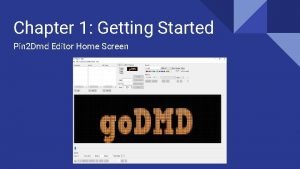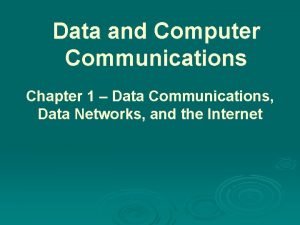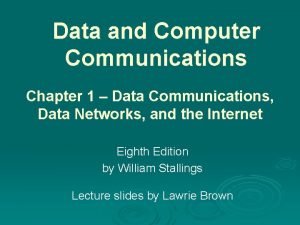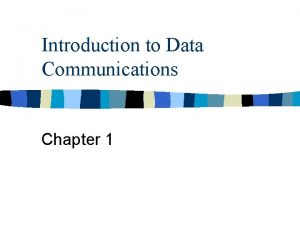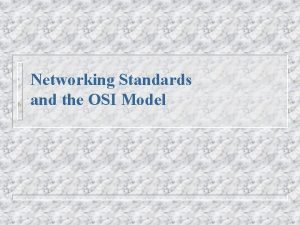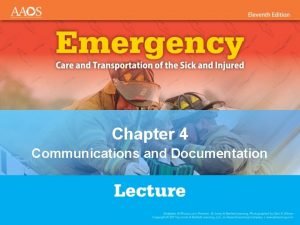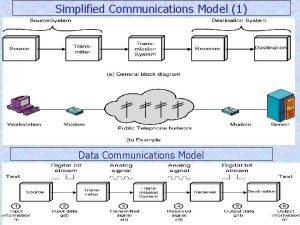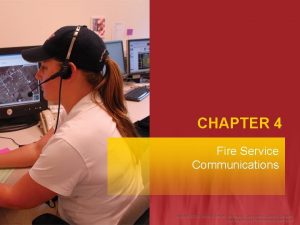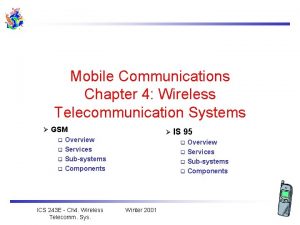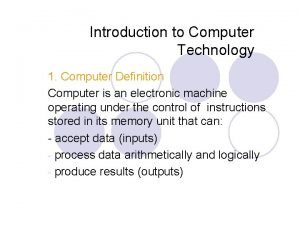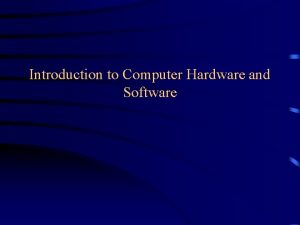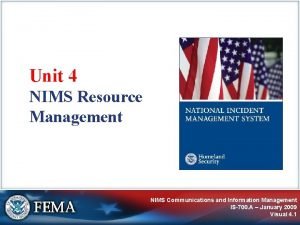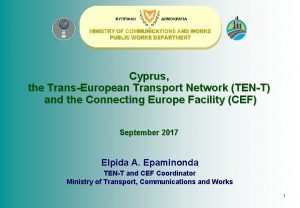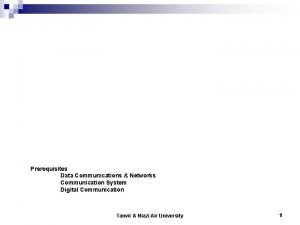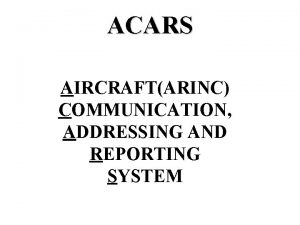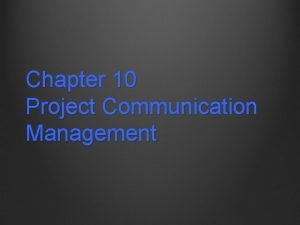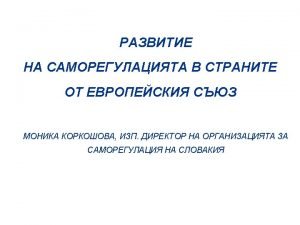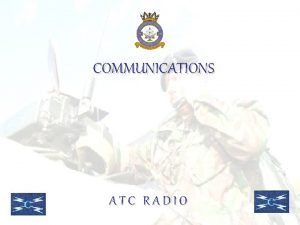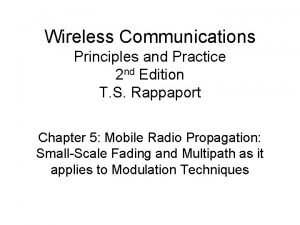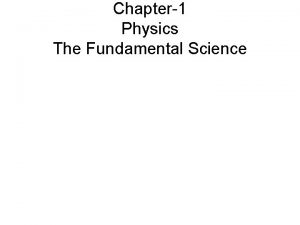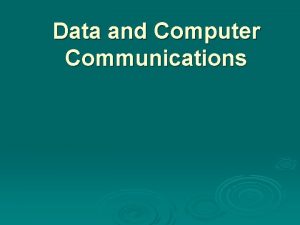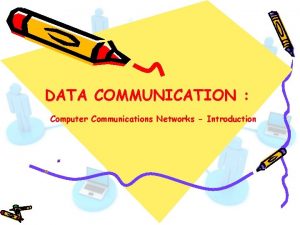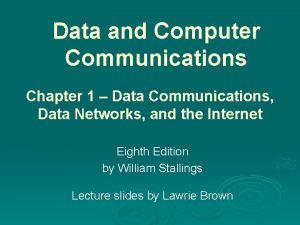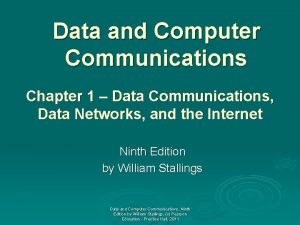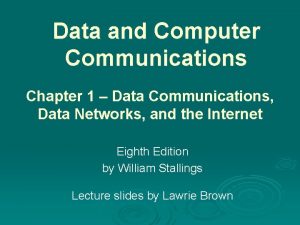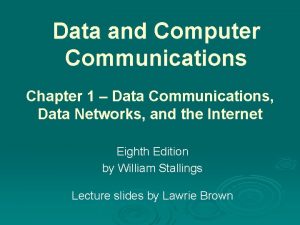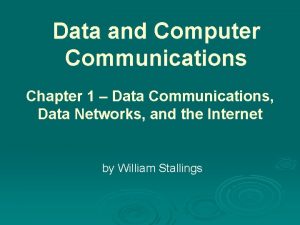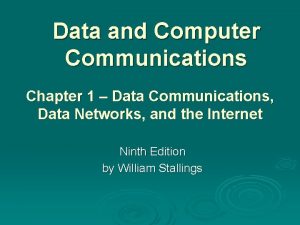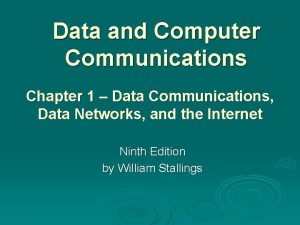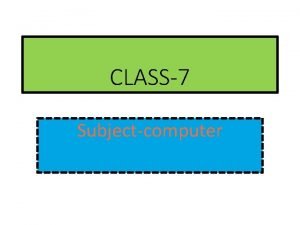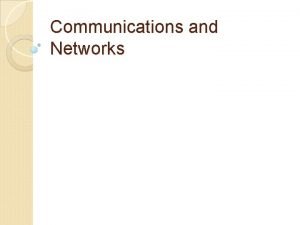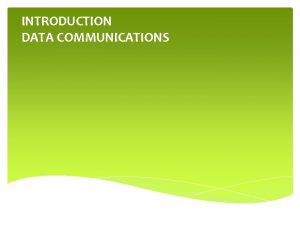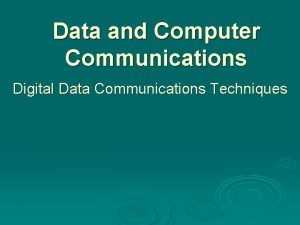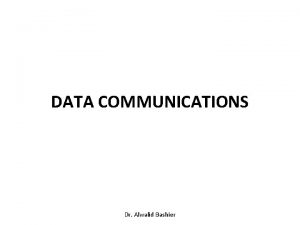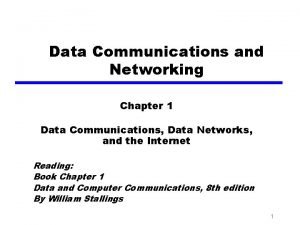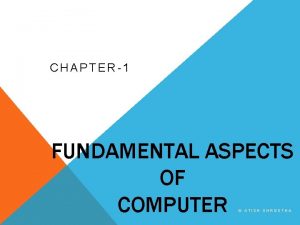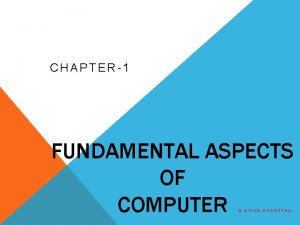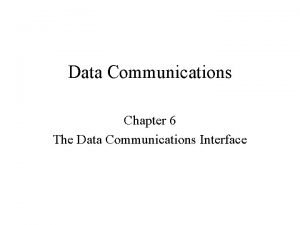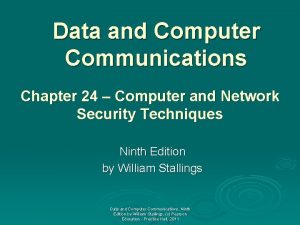Data and Computer Communications Chapter 1 Introduction Chapter1










































- Slides: 42

Data and Computer Communications Chapter 1 Introduction Chapter-1" 1

EE 4603 - Book: “Data and Computer Communications, ” by Wm. Stallings (not the same as “Metropolitan & Local Area Networks”). Author’s Web site: William. Stallings. com/DCC 6 e. html Power. Point files available from: ftp: //ftp. prenhall. com/pub/esm /computer_science. s-041/stallings/Slides/DCC 6 e-Slides/ (or use link on class Web page below). Instructor’s E-Mail: mazim 12@yahoo. com Chapter-1" 2

A Communications Model z Source ygenerates data to be transmitted z Transmitter y. Converts data into transmittable signals z Transmission System y. Carries data z Receiver y. Converts received signal into data z Destination y. Takes incoming data Chapter-1" 3

Simplified Communications Model - Diagram Chapter-1" 4

Key Communications Tasks z Transmission System Utilization z Interfacing z Signal Generation z Synchronization z Exchange Management z Error detection and correction z Addressing and routing z Recovery z Message formatting z Security z Network Management Chapter-1" 5

Simplified Data Communications Model Chapter-1" 6

Networking z Point to point communication not usually practical y. Devices are too far apart y. Large set of devices would need impractical number of connections z Solution is a communications network Chapter-1" 7

Simplified Network Model Chapter-1" 8

Wide Area Networks z Large geographical area z Crossing public rights of way z Rely in part on common carrier circuits z Alternative technologies y. Circuit switching y. Packet switching y. Frame relay y. Asynchronous Transfer Mode (ATM) Chapter-1" 9

A. Circuit Switching z Dedicated communications path established for the duration of the conversation z e. g. telephone network Guaranteed Delivery Chapter-1" 10

B. Packet Switching z Data sent out of sequence z Small chunks (packets) of data at a time z Packets passed from node to node between source and destination z Used for terminal to computer and computer to computer communications Robustness and Efficiency Chapter-1" 11

C. Frame Relay z Packet switching systems have large overheads to compensate for errors z Modern systems are more reliable z Errors can be caught in end system z Most overhead for error control is stripped out Chapter-1" 12

D. Asynchronous Transfer Mode z z z ATM Evolution of frame relay Little overhead for error control Fixed packet (called cell) length Anything from 10 Mbps to Gbps Constant data rate using packet switching technique Chapter-1" 13

Integrated Services Digital Network z ISDN z Designed to replace public telecom system z Wide variety of services z Entirely digital domain Chapter-1" 14

Local Area Networks (LAN) z Smaller scope y. Building or small campus z Usually owned by same organization as attached devices z Data rates much higher z Usually broadcast systems z Now some switched systems and ATM are being introduced Chapter-1" 15

Protocols z Used for communications between entities in a system z Must speak the same language z Entities y. User applications ye-mail facilities yterminals z Systems y. Computer y. Terminal y. Remote sensor Chapter-1" 16

Key Elements of a Protocol z Syntax y. Data formats y. Signal levels z Semantics y. Control information y. Error handling z Timing y. Speed matching y. Sequencing Chapter-1" 17

Protocol Architecture z Task of communication broken up into modules z For example file transfer could use three modules y. File transfer application y. Communication service module y. Network access module Chapter-1" 18

Simplified File Transfer Architecture Chapter-1" 19

A Three Layer Model z Network Access Layer z Transport Layer z Application Layer Chapter-1" 20

A. Network Access Layer z Exchange of data between the computer and the network z Sending computer provides address of destination z May invoke levels of service z Dependent on type of network used (LAN, packet switched etc. ) Chapter-1" 21

B. Transport Layer z Reliable data exchange z Independent of network being used z Independent of application Chapter-1" 22

C. Application Layer z Support for different user applications z e. g. e-mail, file transfer Chapter-1" 23

Addressing Requirements z Two levels of addressing required z Each computer needs unique network address z Each application on a (multi-tasking) computer needs a unique address within the computer y. The service access point or SAP Chapter-1" 24

Protocol Architectures and Networks Chapter-1" 25

Protocols in Simplified Architecture Chapter-1" 26

Protocol Data Units (PDU) z At each layer, protocols are used to communicate z Control information is added to user data at each layer z Transport layer may fragment user data z Each fragment has a transport header added y. Destination SAP y. Sequence number y. Error detection code z This gives a transport protocol data unit Chapter-1" 27

Network PDU z Adds network header ynetwork address for destination computer y. Facilities requests Chapter-1" 28

Operation of a Protocol Architecture Chapter-1" 29

TCP/IP Protocol Architecture z Developed by the US Defense Advanced Research Project Agency (DARPA) for its packet switched network (ARPANET) z Used by the global Internet z No official model but a working one. y. Application layer y. Host to host or transport layer y. Internet layer y. Network access layer y. Physical layer Chapter-1" 30

Physical Layer z Physical interface between data transmission device (e. g. computer) and transmission medium or network z Characteristics of transmission medium z Signal levels z Data rates z etc. Chapter-1" 31

Network Access Layer z Exchange of data between end system and network z Destination address provision z Invoking services like priority Chapter-1" 32

Internet Layer (IP) z Systems may be attached to different networks z Routing functions across multiple networks z Implemented in end systems and routers Chapter-1" 33

Transport Layer (TCP) z Reliable delivery of data z Ordering of delivery Chapter-1" 34

Application Layer z Support for user applications z e. g. http, SMPT Chapter-1" 35

TCP/IP Protocol Architecture Model Chapter-1" 36

OSI Model z Open Systems Interconnection z Developed by the International Organization for Standardization (ISO) z Seven layers z A theoretical system delivered too late! z TCP/IP is the de facto standard Chapter-1" 37

OSI Layers z Application z Presentation z Session z Transport z Network z Data Link z Physical Chapter-1" 38

OSI v TCP/IP Chapter-1" 39

Standards z Required to allow for interoperability between equipment z Advantages y. Ensures a large market for equipment and software y. Allows products from different vendors to communicate z Disadvantages y. Freeze technology y. May be multiple standards for the same thing Chapter-1" 40

Standards Organizations z Internet Society z ISO z ITU-T (formally CCITT) z ATM forum Chapter-1" 41

Further Reading z Stallings, W. Data and Computer Communications (6 th edition), Prentice Hall 1999 chapter 1 z Web site for Stallings book ywww. shore. net/~ws/DCC 6 e. html z Web sites for IETF, IEEE, ITU-T, ISO z Internet Requests for Comment (RFCs) z Usenet News groups ycomp. dcom. * ycomp. protocols. tcp-ip Chapter-1" 42
 Of mice and men chapter1
Of mice and men chapter1 Revelation chapter1
Revelation chapter1 Pin 2 dmd
Pin 2 dmd Data and computer communications 10th edition
Data and computer communications 10th edition Data & computer communications
Data & computer communications Data and computer communications
Data and computer communications William stallings data and computer communications
William stallings data and computer communications Introduction to data communications and networking
Introduction to data communications and networking Introduction to data communications
Introduction to data communications Means of telecommunication
Means of telecommunication Backbone network components
Backbone network components Business data communications and networking
Business data communications and networking Business data communications and networking
Business data communications and networking Network communication models
Network communication models Chapter 4 communications and documentation quiz
Chapter 4 communications and documentation quiz Chapter 3 network protocols and communications
Chapter 3 network protocols and communications Introduction to data warehousing and data mining
Introduction to data warehousing and data mining Data communications model
Data communications model Chapter 4 fire service communications quiz
Chapter 4 fire service communications quiz Communications chapter
Communications chapter Objectives of computer
Objectives of computer Difference between a computer and computer system
Difference between a computer and computer system Monitor printer speaker and projector are blank devices
Monitor printer speaker and projector are blank devices Difference between computer architecture and organisation
Difference between computer architecture and organisation Introduction to computer organization and architecture
Introduction to computer organization and architecture Introduction to computer technology
Introduction to computer technology Definition hardware software
Definition hardware software Track and report nims
Track and report nims Ministry of communications and works cyprus
Ministry of communications and works cyprus Global marketing and communications
Global marketing and communications Designing and managing integrated marketing communications
Designing and managing integrated marketing communications Digital communications and networks
Digital communications and networks K state communications and marketing
K state communications and marketing Business communications process and product
Business communications process and product Business communications process and product
Business communications process and product Acars format
Acars format Designing and managing integrated marketing communications
Designing and managing integrated marketing communications Monitor communications process tools and techniques
Monitor communications process tools and techniques Attitudes and persuasive communications
Attitudes and persuasive communications Easa advertising
Easa advertising Atc communications and radio procedures
Atc communications and radio procedures Designing and managing integrated marketing communications
Designing and managing integrated marketing communications Wireless communications: principles and practice
Wireless communications: principles and practice


